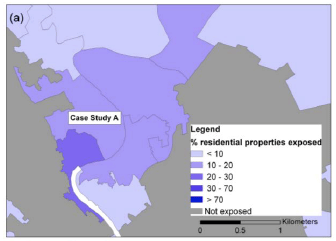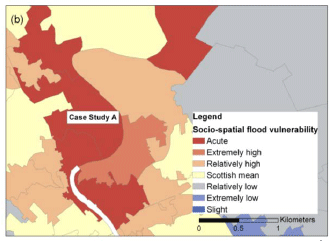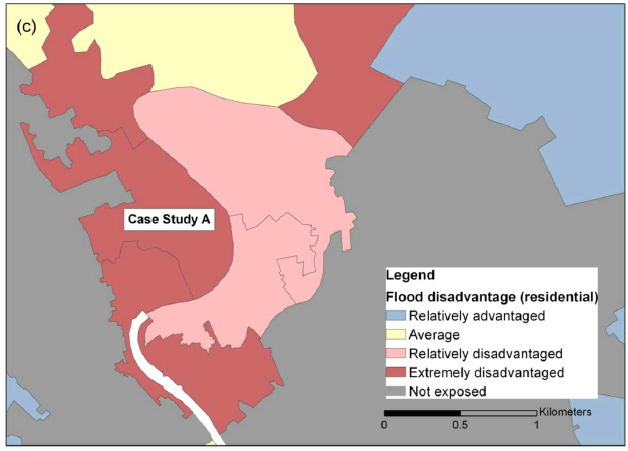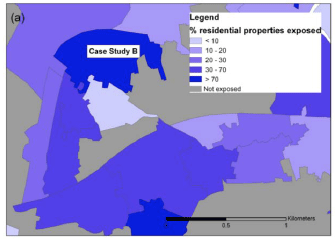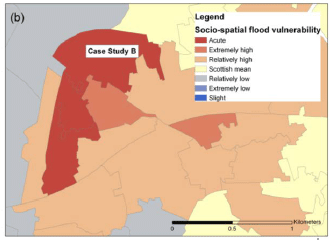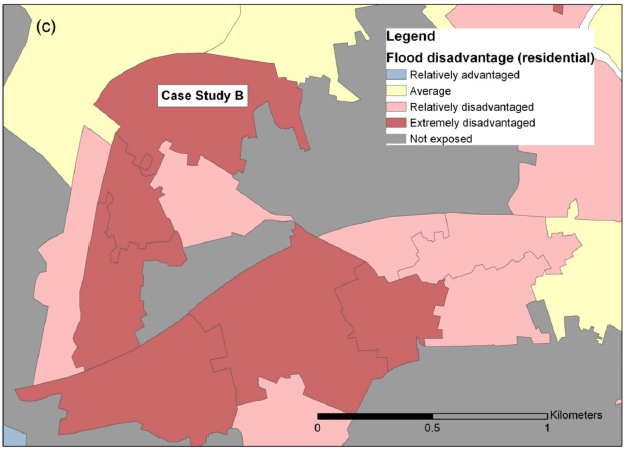Flood disadvantage in Scotland: mapping the potential losses in well-being
This Scottish research looks at the communities most socially and spatially vulnerable to potential flood events in terms of their underlying characteristics (i.e. socio-demographic data such as age and health, spatial and physical characteristics of the neighbourhood), with a focus on mapping flood disadvantage (i.e. socio-spatial vulnerability combined with the probability of being flooded).
3 Results and Discussion
3.1 The primary means of reporting the flood disadvantage results is in map form. Associated summaries are provided which identify the relative number and proportions of neighbourhoods classified as 'extremely flood disadvantaged' within Scottish local authorities (LA).
Disadvantage according to residential flood exposure
3.2 34% of Scottish neighbourhoods contain residential properties which are potentially exposed to some form of coastal or fluvial flooding (Table 2). Of the potentially exposed neighbourhoods, 184 (8.2%) are estimated to be 'extremely flood disadvantaged', i.e. they typically have a high potential for losses in well-being and a high proportion of residential properties potentially affected by flood events, relative to the Scottish average[11]. These neighbourhoods represent 2.8% of all Scottish neighbourhoods.
3.3 Case Studies A and B (page 18) are both within this group of 184 'extremely flood disadvantaged' neighbourhoods. The geographical distribution of flood disadvantage as a result of residential property exposure to coastal and fluvial flooding is shown in Figure 3.
Table 2 Neighbourhood flood exposure and disadvantage associated with residential addresses by different coastal and fluvial flood types.
| Flood type (code used in Figures 5 and 6) | % of neighbourhoods exposed | extremely disadvantaged as a % of exposed neighbourhoods | extremely disadvantaged as a % of all neighbourhoods |
|---|---|---|---|
| 1:100 undefended fluvial (F100) | 25.1 | 7.7 | 1.9 |
| 1:200 undefended fluvial (F200) | 27.9 | 7.3 | 2.0 |
| 1:1000 undefended fluvial (F1000) | 26.5 | 7.8 | 2.1 |
| 1:100 undefended coastal (C100) | 7.8 | 9.2 | 0.7 |
| 1:200 undefended coastal (C200) | 8.4 | 8.6 | 0.7 |
| 1:1000 undefended coastal (C1000) | 8.7 | 9.2 | 0.8 |
| Any flood type[12] | 34.4 | 8.2 | 2.8 |
Figure 3 Flood disadvantage associated with residential property exposure to any coastal or fluvial flood recurrence type
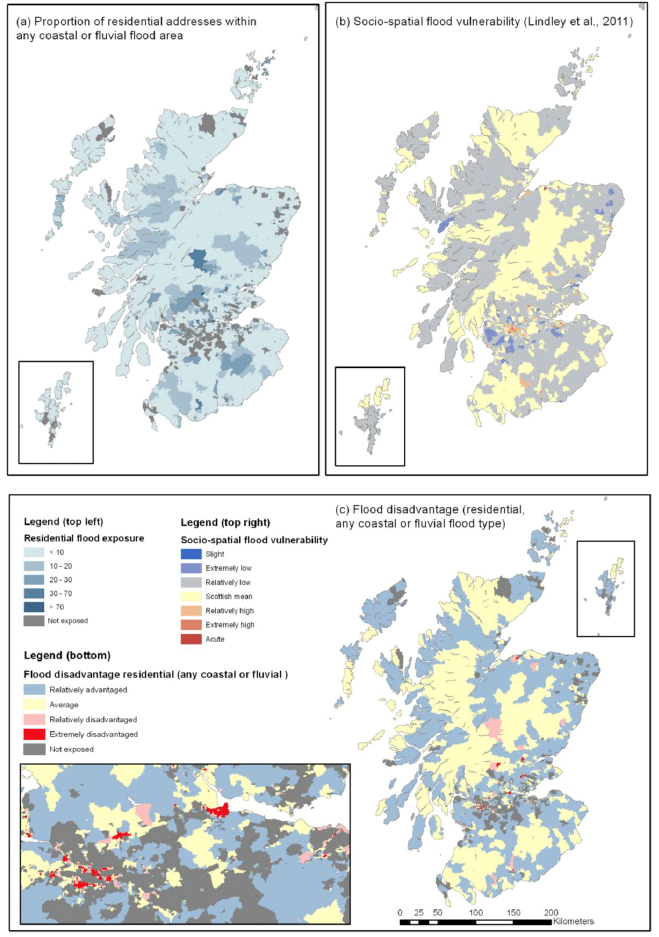
Figure 4 Proportions of neighbourhoods in each local authority classed as having extreme flood disadvantage with respect to residential exposure to any coastal of fluvial flood recurrence type
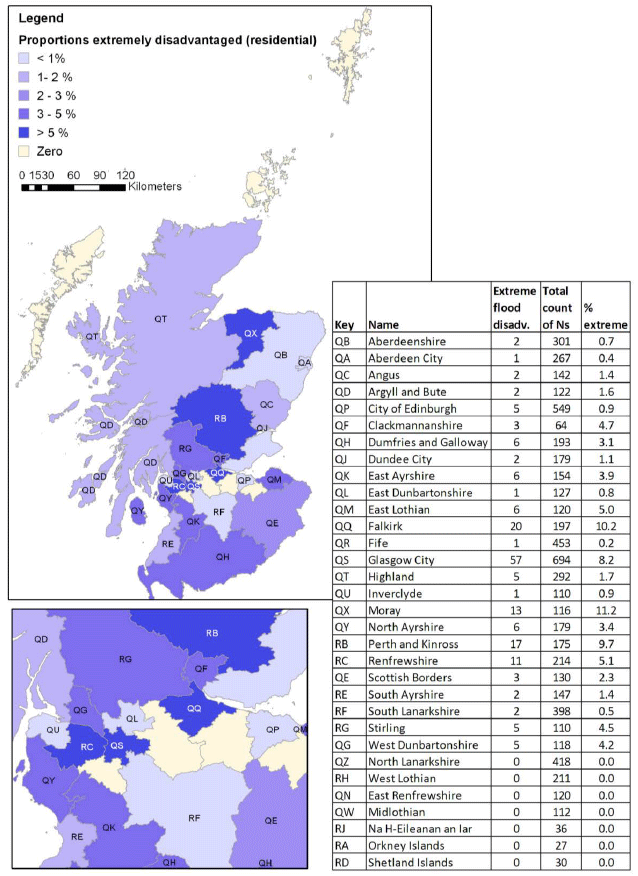
Figure notes: Only LAs with one or more 'extremely flood disadvantaged' neighbourhood are labelled on the map. Key: Extreme flood disadv: count of neighbourhoods (Ns) in the LA estimated to be 'extremely flood disadvantaged'.
3.4 The largest proportions of 'extremely flood disadvantaged' neighbourhoods for residential exposure to coastal or fluvial floods are found in the local authorities of Moray and Falkirk. Within each, more than 10% of neighbourhoods are classed as 'extremely flood disadvantaged' (Figure 4). Other local authorities with high proportions of 'extremely flood disadvantaged' neighbourhoods are Perth and Kinross (9.7%) and Glasgow City (8.2%).
3.5 Seven local authorities have no 'extremely flood disadvantaged' neighbourhoods. They may however still contain relatively flood disadvantaged neighbourhoods or have extreme socio-spatial flood vulnerability in one or more dimensions of socio-spatial flood vulnerability.
3.6 Figures 5-8 (pages 13-16) show how 'extremely flood disadvantaged' neighbourhoods, with respect to residential properties, are distributed by flood type and local authority[13]. Full breakdowns are provided in Appendix 3 (Table A3.1). Figures 5 and 6 relate to fluvial flooding and Figures 7 and 8 relate to coastal flooding.
3.7 Moray, Perth and Kinross and Glasgow City have the largest proportions of 'extremely flood disadvantaged' neighbourhoods (as a share of their total number of neighbourhoods) in relation to fluvial flooding (Figure 5). Glasgow City has the largest overall share of Scotland's 'extremely flood disadvantaged' neighbourhoods associated with fluvial flooding. It contains between 20-40% of the Scottish total depending on fluvial flood likelihood type (Figure 6).
3.8 The local authority of Falkirk has the largest proportion of 'extremely flood disadvantaged' neighbourhoods in relation to coastal flooding (Figure 7). Falkirk also has the largest overall share of the Scottish total of 'extremely flood disadvantaged' neighbourhoods in relation to coastal flooding. Falkirk contains between a fifth and a quarter of the Scottish total, depending on the coastal flood likelihood type (Figure 8).
Figure 5 Relative proportions of all neighbourhoods within the named local authority classed as 'extremely flood disadvantaged' with respect to residential properties and fluvial flood type[14]. Tables 1 and 2 explain the flood recurrence type categories.
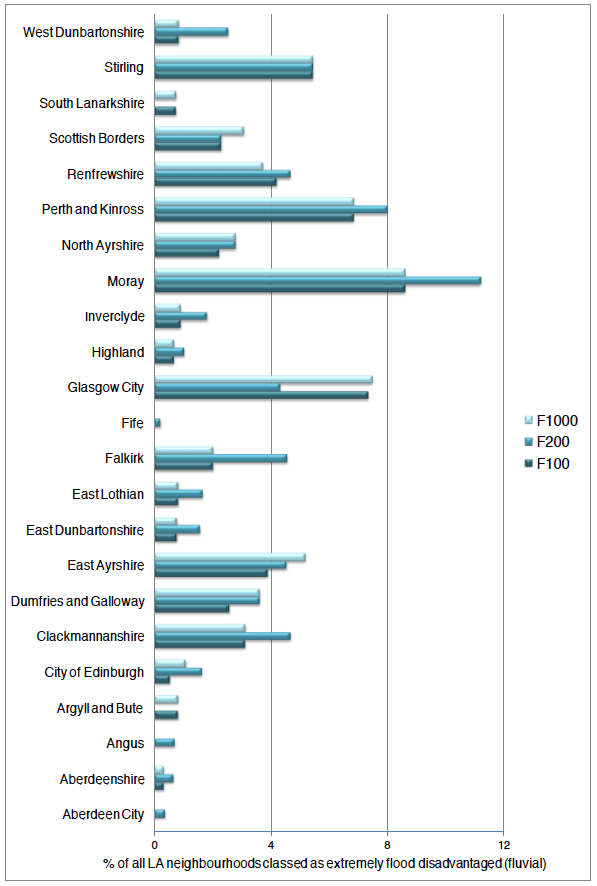
Figure 6 Relative contributions to Scotland's total number of 'extremely flood disadvantaged' neighbourhoods from the named local authority with respect to residential properties and fluvial flood type. Tables 1 and 2 explain the flood recurrence type categories[15].
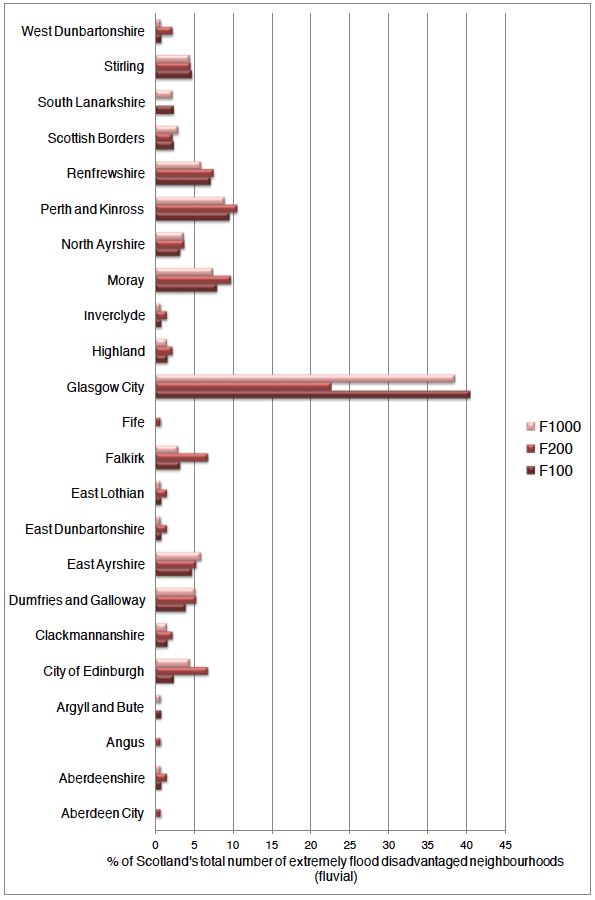
Figure 7 Relative proportions of all neighbourhoods within the named local authority classed as 'extremely flood disadvantaged' with respect to residential properties and coastal flood type. Tables 1 and 2 explain the flood recurrence type categories[16].
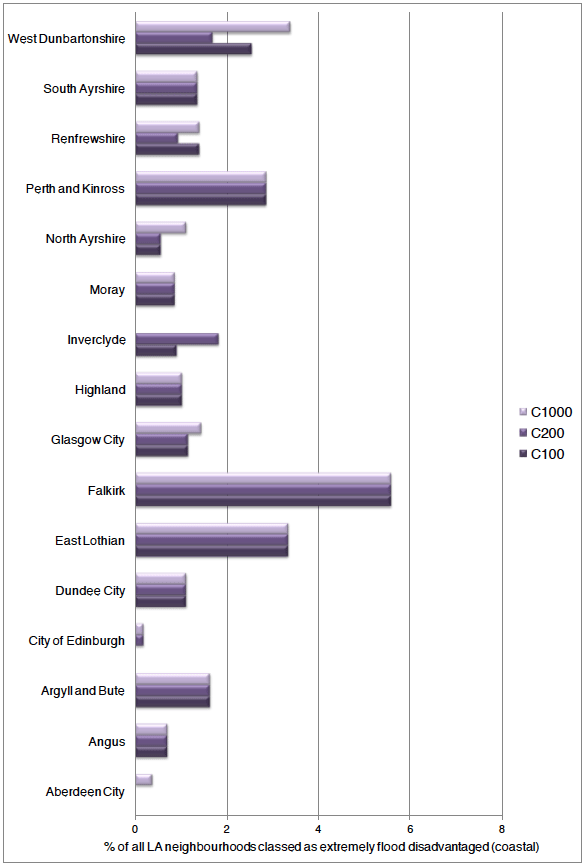
Figure 8 Relative contributions to Scotland's total number of 'extremely flood disadvantaged' neighbourhoods from the named local authority with respect to residential properties and coastal flood type. Tables 1 and 2 explain the flood recurrence type categories[17].
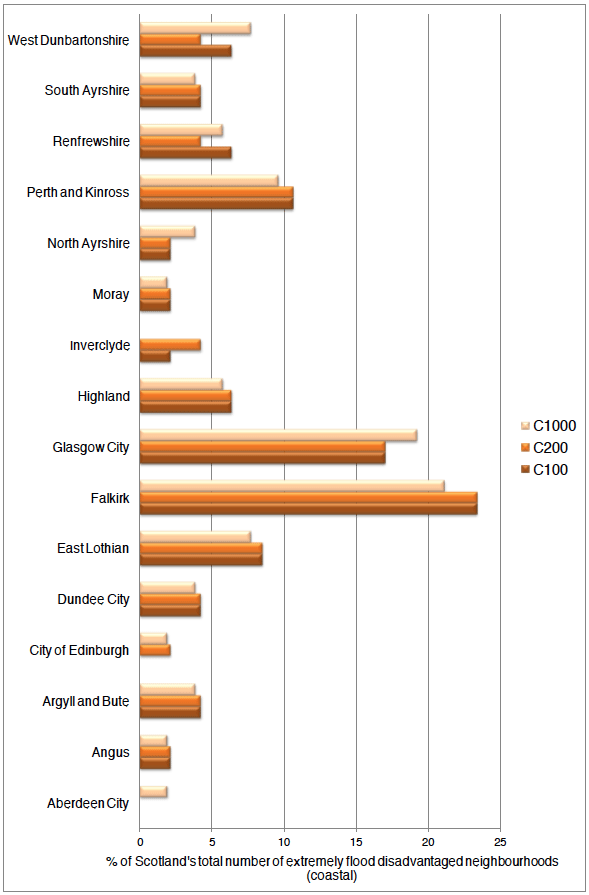
3.9 The methodology used in this report is not intended to replace that of SEPA's (2011) National Flood Risk Assessment (NFRA). Rather it is intended to complement it by providing an assessment of where there is most potential for floods to result in losses in well-being based on underlying personal, environmental and social characteristics. These research findings are presented as a basis for discussion and potential further development.
3.10 The NFRA considers a wide range of metrics representing people, businesses, the environment and cultural heritage in order to identify 'Potentially Vulnerable Areas' (PVA) based on river catchments. PVAs are identified where "the total impact of floods in a given area is considered nationally significant" (NFRA, 2011: 12). They are the focus for flood risk management planning in the form of more detailed flood hazard/risk maps and the appraisal of measures to inform flood risk management strategies and local flood risk management plans[18].
3.11 Unsurprisingly, there are some differences between the results presented in this report and the results of the NFRA. This is likely due to SEPA's use of the following: different thresholds to establish extreme cases; different indicators being used to express flood vulnerability and risk; and different underlying data being used as the basis of the assessment. Case Study C, having been selected from one of the areas highlighted as vulnerable by SEPA, is not identified as having extreme socio-spatial flood vulnerability or as being 'extremely flood disadvantaged' in the current study. The discussion of Case Study C (paragraph 3.21) illustrates that useful information can be obtained through the investigation of neighbourhood vulnerability characteristics even where aggregate scores do not highlight neighbourhoods as having extreme socio-spatial flood vulnerability or as being 'extremely flood disadvantaged'.
3.12 Scotland's NFRA (SEPA, 2011: 11) assesses exposure relative to 14 Local Plan Districts. Although not directly comparable to the results produced in this work, estimates of proportions of properties exposed, appear to be in broad agreement. Results are also similar to those reported in GI-SAT (2007). They are not expected to be an exact match due to differences in the Indicative River & Coastal Flood Map (Scotland) versions and Address Point years used, as well as the reasons outlined above. Visual comparison of results with finer scale datasets (such as the NFRA Risk Grid) hosted on the National Flood Risk Assessment online portal (SEPA, 2013) suggest that further comparative work would be valuable. Such work could, for example, take a closer look at the areas identified as vulnerable and at risk in the SEPA analysis, by reviewing aggregate scores and the scores associated with each vulnerability dimension, domain and indicator on a case-by-case basis.
3.13 The neighbourhoods identified as being 'extremely flood disadvantaged', could benefit from targeted adaptation measures. Further detailed consideration of these neighbourhoods is recommended, i.e. the 184 Scottish neighbourhoods which are estimated to be 'extremely flood disadvantaged' with respect to potential coastal or fluvial flooding (see paragraph 3.2). The aims of additional work would be to verify the exposure and vulnerability characteristics of the exposed people and places and if confirmed, to establish the most appropriate suite of adaptation measures. The measures can be informed by the personal, social and environmental characteristics of individuals and their neighbourhoods as well as the probability and severity of flooding itself.
Case study examples
3.14 Two case study areas (A and B), are among the 184 extremely disadvantaged neighbourhoods identified in paragraph 3.2. These are used as examples to demonstrate how socio-spatial flood vulnerability data can help highlight the specific drivers of social vulnerability in an area and ultimately inform the design of appropriate adaptation strategies. A third case study has been selected as a less extreme example, as explained in 3.11.
Figure 9 Flood disadvantage characteristics for Case Study A
(a) Flood hazard exposure (residential property exposure to any coastal or fluvial flooding recurrence type);
(b) socio-spatial flood vulnerability; and
(c) associated flood disadvantage.
3.15 Case Study A is a neighbourhood in south-west Scotland. Around 10% of all residential properties in the neighbourhood are exposed to coastal or fluvial flooding (Figure 9a) and there is acute socio-spatial flood vulnerability which is three standard deviations (three classes) above the Scottish mean (Figure 9b). This explains the extreme flood disadvantage identified by the analysis (Figure 9c).
Figure 10 Dimensions of socio-spatial vulnerability in Case Study A[19]
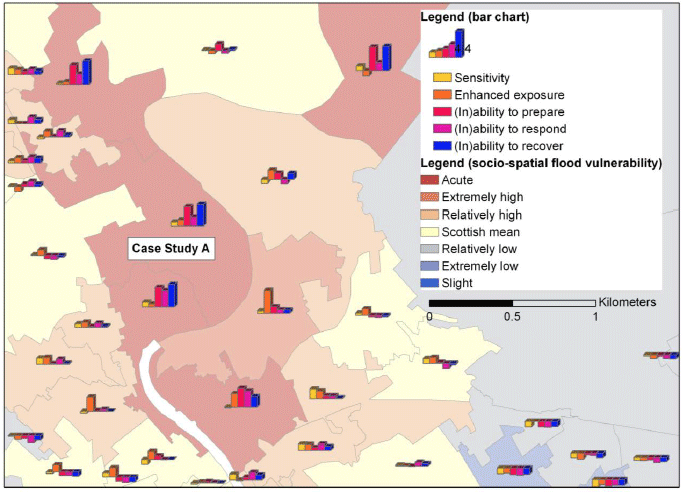
3.16 Figure 10 provides a breakdown of Case Study A's socio-spatial vulnerability characteristics. It shows the relative contributions of the five dimensions of vulnerability identified in Lindley et al. (2011): sensitivity; enhanced exposure; ability to prepare; ability to respond; and ability to recover. This information is layered over the socio-spatial flood vulnerability map from Figure 9b.
- Sensitivity: This neighbourhood has an above average proportion of people over 75 (9%) and reporting ill-health (25%), compared to the Scottish neighbourhood average of 7% and 20%, respectively.
- Enhanced Exposure: The neighbourhood is more urban than most, which can enhance the impacts of flood events relative to other areas. However, the area does benefit from a lower than average proportion of basement dwellings (dwellings where the lowest floor level is basement or semi-basement - see Table A1.2), so the building stock does not enhance flood impacts.
- Adaptive capacity: Most of the vulnerability in this neighbourhood results from social factors.
- Relatively low household incomes restrict the extent to which people have resources to assist with flood preparation, response and recovery.
- There are low private tenancy rates, but the large proportion of social renters (48% compared to a mean of 26%) indicates that many in the neighbourhood may be restricted in terms of adapting their homes. While this is a restriction for householders, it presents an opportunity for local authorities to assist with adapting building stock appropriately.
- Insurance access may be difficult or expensive due to historical flood events in the area. The effects of income and tenure that are relevant to insurance access are discussed further in 3.17 below.
- The area is associated with a slightly larger rate of transience than in many Scottish neighbourhoods, but local awareness of flood issues may still be reasonably high compared with neighbourhoods where the population is subject to a very high turnover rate.
- There is the possibility for some social isolation due to higher than usual proportions of lone parents with dependent children. This and a lack of access to private transport (45% of households without access to a car or van), may make responding to flood events difficult for some in the community.
- Mobility issues are also suggested due to the higher than average proportions of disability in the neighbourhood (10% compared to 7% for the Scottish average).
3.17 Case Study B is a neighbourhood in the central lowlands. Around 74% of all residential properties in the neighbourhood are exposed to coastal or fluvial flooding (Figure 11a) and there is acute socio-spatial flood vulnerability which is over three standard deviations (three classes) above the Scottish mean (Figure 11b). Consequently, this neighbourhood is classed as 'extremely flood disadvantaged' (Figure 11c).
Figure 11 Flood disadvantage characteristics for Case Study B
(a) Flood hazard exposure (residential property exposure to any coastal or fluvial flooding recurrence type);
(b) socio-spatial flood vulnerability; and
(c) associated flood disadvantage.
3.18 Figure 12 provides a breakdown of Case Study B's socio-spatial vulnerability characteristics. It shows the relative contributions of the five dimensions of vulnerability identified in Lindley et al., 2011: sensitivity; enhanced exposure; ability to prepare; ability to respond and ability to recover. This information is layered over the socio-spatial flood vulnerability map from Figure 10b.
- Sensitivity: Sensitivity in this neighbourhood is primarily driven by two factors: a larger than usual proportion of children under 5 (8%) and reported ill-health (29%), compared to Scottish averages of 7% and 20%, respectively. There is a much lower proportion of residents over 75, at just 3% compared to 7% for the Scottish average. Community level health information could be targeted at children and families and through existing routes, such as doctors and health visitors. Some consideration of other sensitive groups on an individual basis would still be necessary, as is the case in all neighbourhoods.
Figure 12 Dimensions of socio-spatial vulnerability in Case Study B[20]
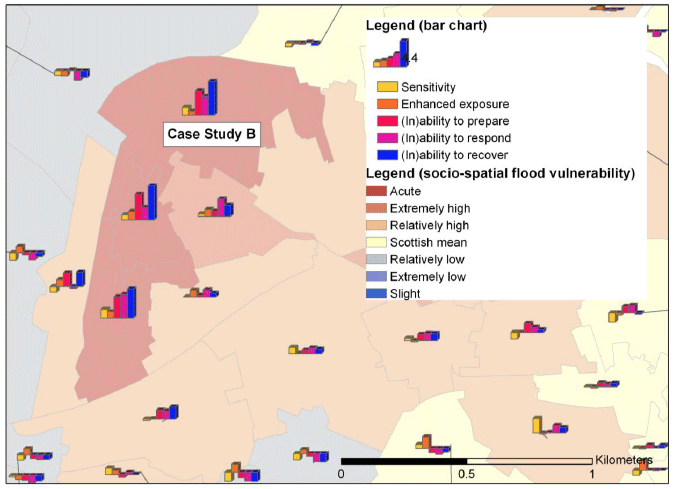
- Enhanced Exposure: The local environment of this neighbourhood has only a slight tendency to enhance the potential impacts of flooding. The neighbourhood is not associated with a disproportionately large amount of dwellings where the lowest floor level is basement or semi-basement. However, the area is generally more built up than the average Scottish neighbourhood.
- Adaptive capacity: In common with Case Study A, most of the vulnerability in this neighbourhood is socially determined.
- Around two-thirds (66%) are classified as income deprived compared to 17% in the average Scottish neighbourhood. People can therefore be expected to have few or no resources available for long-term preparation, may be less able to respond to flooding and may also find recovery extremely difficult.
- Given the history of past events in the area, access to affordable flood insurance may be an issue. Insurance uptake is also likely to be affected by the high proportion of low income households. The 2007 Scottish Household Survey showed 60% of households in the lowest income decile have contents insurance, compared to 96% of those in the two highest income deciles (Hayton et al., 2007, 4.46). Moreover, given the very large proportion of social tenants (74% compared to 26%), the level of uptake for contents insurance will be lower than that for owner-occupiers. The 2007 Scottish Household Survey also found that 56% of local authority tenants and 50% of housing association, cooperative or private tenants had contents insurance, compared to 98% of owner-occupiers with a mortgage (Hayton et al., 2007, 4.48; O'Neill and O'Neill, 2012:5). Low-cost 'insurance-with-rent' schemes with minimal or no excess charges and security conditions have been directed at the rented sector, although their uptake has been mixed (Hood et al., 2009). Social tenants may be assisted with appropriate modifications of building stock.
- Indicators suggest that the area is associated with low transience, so local community knowledge of flood problems may be relatively good.
- There are very large proportions of lone parents with dependent children (22%). Some within this group may be socially isolated and many may find responding to flood events challenging. Separated and single people are also less likely to have home contents insurance (72% and 66%, compared to 94% of married couples) (Hayton et al., 2007).
- Rates of disability and households without access to private transport are more than twice the Scottish average. This and a strong dependency on public transport for work (31% compared to 18%), may also make responding difficult. Any relocation of householders following an event could cause additional problems.
3.19 The final two case studies are located in the north. Case Study C is a large rural neighbourhood and Case Study D shows a number of neighbourhoods associated with a town.
3.20 Figure 13 shows that although overall, Case Study C is not an especially socially vulnerable area, the community in this area has a higher than average sensitivity. This is driven by a higher than average proportion of people over 75 years of age. Part of this neighbourhood is also highlighted in SEPA's NFRA.
3.21 Case Study C illustrates that the use of an aggregate index alone can mask some important social flood vulnerability characteristics. It should also be noted that area-based averages do not apply to all individuals within neighbourhoods, even where boundaries have been initially designed to take account of social characteristics (see 2.6). All Scottish neighbourhoods are likely to contain some socially vulnerable people, even where the neighbourhoods that they live in are assessed as having low or extremely low socio-spatial flood vulnerability. Assessments like this can help to target some adaptation responses to areas of particular need. However, such area-based targeting should only form part of a wider suite of adaptation actions, including carrying out activities which target vulnerable groups more generally.
3.22 Case study D (Figure 14) illustrates how there can be different contributions from the different socio-spatial flood vulnerability dimensions across a town. Some neighbourhoods contain a relatively sensitive population (Area D.1) while the population in others may have relatively poor adaptive capacity (Area D.2). Areas D.1-D.3 all show relatively high enhanced exposure, but this is especially marked in Area D.3 and others towards the east of the town.
Figure 13 Dimensions of socio-spatial vulnerability in Case Study C[21] (average socio-spatial vulnerability)
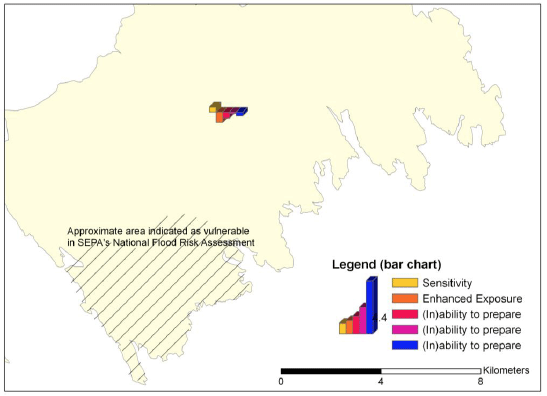
Figure 14 Dimensions of socio-spatial vulnerability in Case Study D[22]. Key: SSFV: Socio-spatial flood vulnerability.
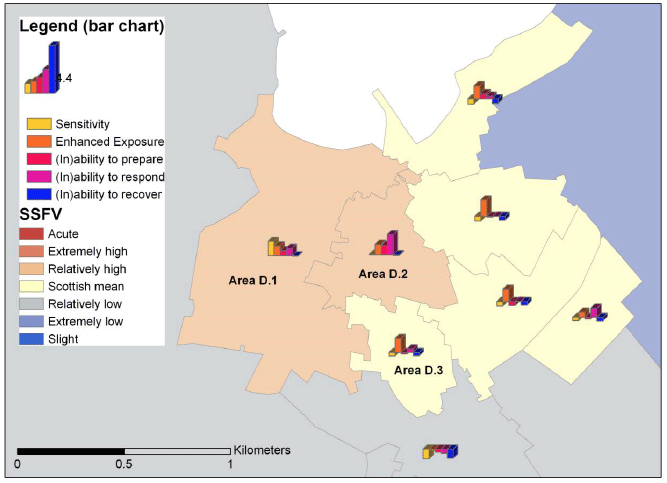
Contact
Email: Jackie Horne
There is a problem
Thanks for your feedback
